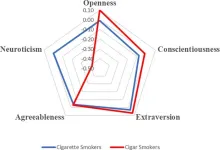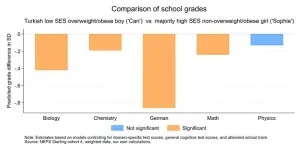(Press-News.org) MINNEAPOLIS – Having higher levels of inflammation in your 20s and 30s may be linked to having memory and thinking problems at middle age, according to a study published in the July 3, 2024, online issue of Neurology®, the medical journal of the American Academy of Neurology. The study looked at levels of C-reactive protein (CRP) in the blood. CRP is produced by the liver and increases when there is inflammation in the body. The study does not prove that having higher levels of this protein causes dementia. It only shows an association.
There are two kinds of inflammation. Acute inflammation happens when the body’s immune response jumps into action to fight off infection or an injury. It is localized, short-term and part of a healthy immune system. Chronic inflammation is not considered healthy. It is a low-grade inflammation that lingers for months or even years throughout the body. It can be caused by autoimmune disorders like rheumatoid arthritis or multiple sclerosis, physical stress or other causes. Symptoms of chronic inflammation include joint pain or stiffness, digestive problems and fatigue.
Ways to reduce chronic inflammation include getting regular exercise, following an anti-inflammatory heart healthy diet and getting enough sleep.
“Late-life inflammation has been linked to dementia risk and the earliest signs of cognitive decline, but less is known about inflammation in young adults and if this could influence cognition in midlife,” said study author Kristine Yaffe, MD, of University of California, San Francisco. “Our study found that having consistently higher or moderate inflammation starting in early adulthood may negatively affect a person’s ability to plan, focus and manage multiple tasks as well as how quickly they can process information in middle age.”
The study involved 2,364 people age 24 to 58. They were followed for 18 years.
Participants’ inflammation levels were measured at the start of the study and three more times throughout the study.
Researchers divided participants into three groups based on inflammation levels: consistently higher, moderate or increasing and lower stable. Of the total participants, 911 people, or 39%, had consistently higher inflammation; 381 people, or 16%, had moderate or increasing inflammation; and 1,072, or 45%, had lower stable inflammation.
Five years after their last inflammation measurement, participants were given six tests to examine thinking and memory skills.
On a test that measures processing speed and memory, participants were given a key showing numbers and corresponding symbols. They then drew those symbols on a separate list of random numbers as quickly as possible. Of those in the low group, 10% had poor cognitive performance, while those in the middle group and high group had 21% and 19%, respectively.
After adjusting for factors such as age, physical activity and total cholesterol, researchers found that both the high and moderate groups were more likely to have poor performance in processing speed and executive function.
For processing speed, researchers found that those in the moderate group were more than two times more likely to have poor performance and those in the highest group were nearly two times more likely to have poor performance than those in the lowest group. For executive function, those with the highest CRP levels had a 36% higher risk of poor performance.
“Inflammation is important for cognitive aging and may begin much earlier than previously known,” said Yaffe. “Although current prevention efforts mainly focus on late life, our study provides evidence for the need to also target brain health in middle age. More research is needed to improve early detection of those at highest risk of poor cognitive performance and to determine effective strategies to delay the process of cognitive aging by addressing the drivers of inflammation.”
A limitation of the study was that other conditions associated with elevated levels of inflammation, such as stroke, high blood pressure and diabetes, were not assessed.
Learn more about dementia at BrainandLife.org, home of the American Academy of Neurology’s free patient and caregiver magazine focused on the intersection of neurologic disease and brain health. Follow Brain & Life® on Facebook, X and Instagram.
When posting to social media channels about this research, we encourage you to use the hashtags #Neurology and #AANscience.
The American Academy of Neurology is the world's largest association of neurologists and neuroscience professionals, with over 40,000 members. The AAN’s mission is to enhance member career fulfillment and promote brain health for all. A neurologist is a doctor with specialized training in diagnosing, treating and managing disorders of the brain and nervous system such as Alzheimer's disease, stroke, concussion, epilepsy, Parkinson's disease, multiple sclerosis, headache and migraine.
For more information about the American Academy of Neurology, visit AAN.com or find us on Facebook, X, Instagram, LinkedIn and YouTube.
END
Can inflammation in early adulthood affect memory, thinking in middle age?
2024-07-03
ELSE PRESS RELEASES FROM THIS DATE:
Poor health, stress in 20s takes toll in 40s with lower cognition
2024-07-03
Higher inflammation in young adulthood linked to lower performance in skills testing in midlife.
Young adults who have higher levels of inflammation, which is associated with obesity, physical inactivity, chronic illness, stress and smoking, may experience reduced cognitive function in midlife, a new study out of UC San Francisco has found.
Researchers previously linked higher inflammation in older adults to dementia, but this is one of the first studies to connect inflammation in early adulthood with lower cognitive abilities in midlife.
“We know from long-term studies that brain changes leading to Alzheimer’s ...
Scientists may have found how to diagnose elusive neuro disorder
2024-07-03
Progressive supranuclear palsy (PSP), a mysterious and deadly neurological disorder, usually goes undiagnosed until after a patient dies and an autopsy is performed. But now, UC San Francisco researchers have found a way to identify the condition while patients are still alive.
A study appearing in Neurology on July 3 has found a pattern in the spinal fluid of PSP patients, using a new high-throughput technology that can measure thousands of proteins in a tiny drop of fluid.
Researchers ...
Cracking the code for cerebellar movement disorders
2024-07-03
The cerebellum is a region of the brain that helps us refine our movements and learn new motor skills. Patients and mouse models experience many kinds of abnormal movements when their cerebellum is damaged. They can have uncoordinated and unbalanced movements, called ataxia. They can have atypical positioning of body parts or uncontrolled movements because their muscles are working against each other, called dystonia. Or they can have disruptive shaky movements, called tremors. Understanding how changes in a single brain region ...
Stability indicating RP-HPLC method for the estimation of impurities in esomeprazole gastro-resistant tablets by AQbD approach
2024-07-03
https://www.scienceopen.com/hosted-document?doi=10.15212/bioi-2024-0018
Announcing a new article publication for BIO Integration journal. Esomeprazole (ESO) gastro-resistant tablets (40 mg) are sold under the brand name, Zosa, which effectively manages conditions associated with the overproduction of gastric acid, including peptic ulcer disease and Zollinger-Ellison syndrome. This article quantifies impurities in esomeprazole using advanced analytical techniques known as analytical quality by design with high-performance liquid chromatography.
Buffer selection ...
Clinical implications and procedural complications in patients with patent foramen ovale concomitant with atrial septal aneurysm
2024-07-03
https://www.scienceopen.com/hosted-document?doi=10.15212/CVIA.2024.0038
Announcing a new article publication for Cardiovascular Innovations and Applications journal. Atrial septal aneurysm (ASA) is defined as excursion of the atrial septum exceeding 10 mm beyond the atrial septum into the right or left atrium, or a combined total excursion of 15 mm on the right and left sides during the cardiac cycle. According to previous studies, 20–40% of patent foramen ovale (PFO) cases are accompanied by ASAs. ASA is associated with the presence of PFO, left atrial dysfunction, cryptogenic stroke, migraine, and arterial embolism, thus making ...
Cryptocurrency investors are more likely to self-report “Dark Tetrad” personality traits alongside other characteristics
2024-07-03
Owning cryptocurrency may be associated with certain personality and demographic characteristics as well as a reliance on alternative or fringe social media sources, according to a study published July 3, 2024 in the open-access journal PLOS ONE by Shane Littrell from the University of Toronto, Canada, along with colleagues from the University of Miami, USA.
Anonymous trading and unregulated markets hallmark cryptocurrency’s unique subculture. While some consider the digital currency to be financially unreliable, hundreds of millions of global investors think otherwise.
This study identified various political, psychological, and social characteristics ...
Smoking behavior is linked to personality traits
2024-07-03
Cigarette smokers, cigar smokers, and non-smokers each have distinct personality profiles, according to a study published July 3, 2024 in the open-access journal PLOS ONE by Dritjon Gruda from Universidade Catolica Portuguesa, Portugal, and Jim McCleskey from Western Governors University, USA.
Tobacco use remains a formidable global public health challenge, responsible for more than 8 million deaths annually, including those attributed to second-hand smoke exposure. Emerging research underscores the critical role of psychological factors, including personality traits, in shaping ...
Minority status, social origin, gender, and weight can all count against a German kid’s grades
2024-07-03
A new study done in more than 14,000 ninth graders in Germany has revealed that students experience grading bias based on their gender, body size, ethnicity and parental socio-economic status. These negative biases stack on each other, meaning that students with multiple intersectional identities get significantly lower grades than their peers regardless of their true abilities. Richard Nennstiel and Sandra Gilgen of the University of Bern and University of Zurich in Switzerland present these findings in the open-access journal PLOS ONE on July 3, ...
Dengue linked to heightened short- and long-term risk of depression in Taiwan
2024-07-03
Analysis of the medical records of nearly 50,000 people who experienced dengue fever in Taiwan suggests that this disease is associated with elevated short- and long-term risk of depression. Hsin-I Shih and colleagues of National Cheng Kung University and National Health Research Institutes, Taiwan present these findings in the open-access journal PLOS Neglected Tropical Diseases.
People may develop dengue fever after being bitten by a mosquito carrying the dengue virus. Dengue fever can be mild, but it can also progress ...
Fighting COVID-19 with a cancer drug
2024-07-03
Twelve years ago, cancer researchers at University of California San Diego identified a molecule that helps cancer cells survive by shuttling damaging inflammatory cells into tumor tissue. In new research, they show that the same molecule does the same thing in lung tissue infected with COVID-19 — and that the molecule can be suppressed with a repurposed cancer drug. The work, published in Science Translational Medicine, represents a new approach to preventing irreversible organ damage in infectious diseases like COVID-19 and methicillin-resistant Staphylococcus aureus (MRSA).
The two key players in this scenario are inflammatory cells called myeloid ...



